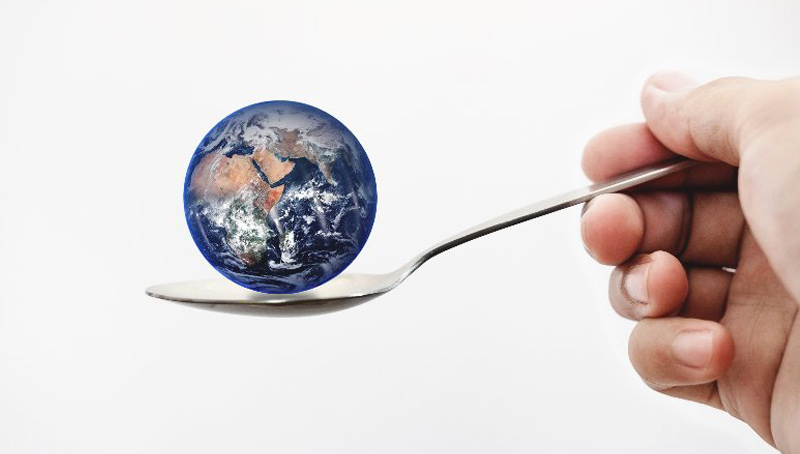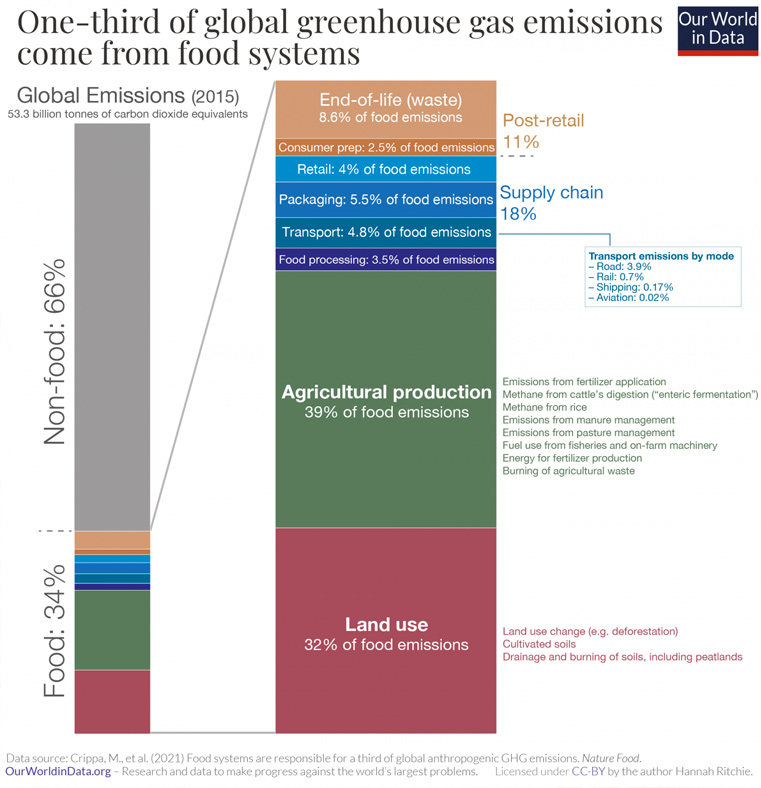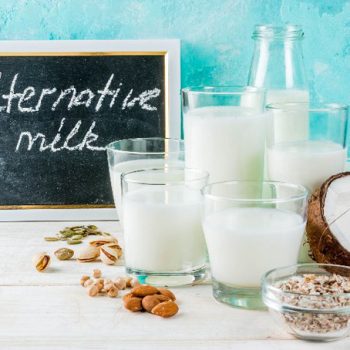
CLIMATE CRISIS, HEALTH and FOOD

At the end of this extreme summer of soaring temperatures, fires, collapsing glaciers, storm surges and tornadoes, we can finally admit that the climate crisis is already here.
Despite the targets set by the World Climate Agreements, we cannot wait any longer: we must all do our part. The good news is that, very often, everyday actions aimed at change do both the planet’s and the individual’s good, placing us in a win-win situation, i.e. where the benefits are for everyone.
This is the case in the area of food choices that have direct effects on both individual health and the environment.
“The food system is responsible for one third of global greenhouse gas emissions from human activities”.
This is the title of the recent report by researchers from the FAO and the European Joint Research Centre in Ispra. The predominant contribution comes from agriculture and land use, while the rest is divided between supply chain activities and final food consumption. In detail, of a total of 17.9 billion tons of CO2 emitted into the atmosphere each year:
– 71% comes from land use (including deforestation and fires for subsequent agricultural exploitation) and emissions from cultivation (production and use of chemical and organic fertilizers), livestock farming, aquaculture and fuel used by agricultural machinery;
– 18% refers to the distribution chain, defined as all processes of industrial food processing, transport, packaging and retail distribution;
– 11% relates to after-sales, divided into food preparation (mainly cooking) and waste management.

Being sustainable is good for your health
The latest epidemiological data report that around 2 billion people worldwide are overweight or obese, while more than 800 million people do not have enough food to eat. This shows that mankind has a problem with food that is multidimensional: the current food system not only has a significant climatic cost, but also has a strong impact on the health of the individual.
Given the enormous cultural, social, economic and landscape diversity, there is no single recipe to solve the planet-wide environmental crisis caused by food production. However, each of us can adopt virtuous behavior at the table that is beneficial to both the individual and the community.
- choose the short supply chain.
Favoring local production means maintaining agro food realities that have been part of the area’s culinary tradition for many generations, while at the same time promoting techniques of sustainable cultivation methods that respect the ecological balance in which the producers themselves live. This leads to a well-being of the economic, social and environmental fabric also for future generations.
- Choose meat from extensive animal husbandry.
For years, red meat has been demonized for its saturated fat content and its role in blood cholesterol levels. However, the lipid profile of meat can undergo important variations depending on the diet of the animal, defining (and improving) the saturated fat/unsaturated fat (MUFA and PUFA) ratio. Choosing meat from grass-fed animals not only means eating meat of a better nutritional quality (higher MUFA and PUFA fats, vitamins and antioxidants), but also decreasing the environmental impact of intensive livestock farming due to the production of soy and maize-based feed and the extremely high water consumption. So, yes to quality red meat, according to recommended consumption frequencies.
- choose sustainable fish.
Dietary guidelines recommend the consumption of fish, with particular reference to fish rich in omega-3 fats, for its health benefits. Nevertheless, it is not mandatory to consume only salmon and tuna. One can undoubtedly choose for locally caught species, diversifying their consumption to give them market value and avoid them being discarded once caught. So let’s go back to consuming ‘poor fish‘ such as hake, gurnard, mackerel, anchovies, mullet, sargo, sardines… as this can help maintain marine biodiversity and avoid the depletion of fish stocks of other species considered more valuable, such as tuna and swordfish. In addition, if the size of the fish in adulthood remains small to medium, it will have accumulated fewer environmental pollutants by the time it is consumed. Finally, species that reach reproductive age quickly are less at risk of extinction from commercial fishing.
- Consider alternatives to cow’s milk
Numerous alternatives to cow’s milk are now widely available. Commonly referred to as vegetable milks, these are beverages obtained by pressing oil seeds, cereals or pulses. The environmental impact of cow’s milk production is significantly higher than that of plant-based beverages in terms of greenhouse gas emissions, land use and fresh water use [4]. Therefore, if you want to reduce the environmental footprint of your diet, switching to plant-based alternatives is a good option. When choosing a plant-based beverage variety, along with one’s taste preferences, one should orient one’s choice according to the principles of lipidomic balance, knowing the lipid profile of each beverage in order to make a personalized choice according to one’s nutritional needs (here our recent article on lipidomic comparison of plant-based beverages).
- Reduce packaging.
For every kg of plastic produced, 1.2 kg of CO2 is emitted into the atmosphere, not counting fuel refining and final waste management. If the absurdity and uselessness of much of the packaging we find in the supermarket does not make us think about the environmental impact, let us then think about the impact of plastic on our health. It is only in recent years that we have begun to talk about endocrine disruptors . These are substances that mimic or antagonize hormone signaling and, for this reason, have strong health effects depending on the age and sex of the individual. Immune, neuroendocrine, reproductive, and metabolic (“obesogenic”) effects have been documented following exposure during pregnancy, growth, puberty, and also on subsequent generations. Some of these compounds have long been used in the production of bottles, containers and food films. These are lipophilic substances (so beware of fatty food packaging!) whose effects do not follow the paradigm of toxicology: no dose-response curve or minimum toxicity value can be defined. Moreover, being highly persistent in the environment, exposure is never acute, but occurs over decades at very low doses, making it extremely difficult to establish a cause-and-effect relationship with hormonal and metabolic disorders.
- reducing household food waste
In the world, there is great inequality regarding access to food. On the one hand, in Western countries there is a high rate of over nutrition and consumption of ultra-processed food with low nutritional value, and on the other hand, in low-income countries, there is great insecurity regarding access to nutritious, safe and adequate food. Despite this, it is estimated that one third of all food produced is wasted because it is unsold or bought and not consumed. This waste not only directly affects the inequalities of the planet, but is equivalent to wasting the precious resources used to produce it, such as soil, energy and water. Reducing food waste may not at first glance have a direct impact on an individual’s health, but it does highlight selfish, compulsive behavior lacking social empathy that, if corrected, benefits every person within the community in which they live.
References:
[1] Crippa, M., Solazzo, E., Guizzardi, D. et al. Food systems are responsible for a third of global anthropogenic GHG emissions. Nat Food 2, 198–209 (2021). https://doi.org/10.1038/s43016-021-00225-9]
[2] www.who.int/health-topics/obesity#tab=tab_1,
[3] https://www.issalute.it/index.php/la-salute-dalla-a-alla-z-menu/i/interferenti-endocrini
[4] https://ourworldindata.org/environmental-impacts-of-food#dairy-vs-plant-based-milk-what-are-the-environmental-impacts
Article by the editorial team of Lipinutragenspan>
The information provided must in no way replace the direct relationship between health professional and patient.
The food recommendations in the article are not intended as a substitute for a personalized meal plan and are to be adapted to specific cases.
Photo: 123RF Archivio Fotografico: 69913899 : ©aamulya | Data source: Crippa. M., et al. (2021) Food system are responsible for a third of global anthropogenic GHG emissions. Nature food. Our WordlsinData.org – Research and data to make progress against the world’s largest problems. Licensed under CC-BY by the author Hannah Ritchie.
- On 29 August 2022



